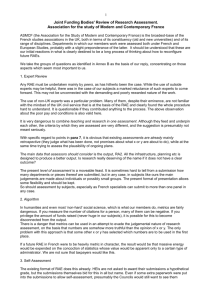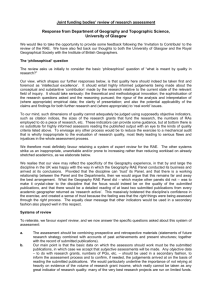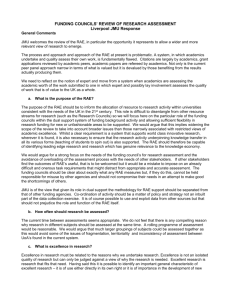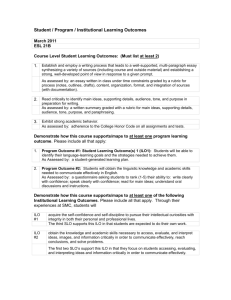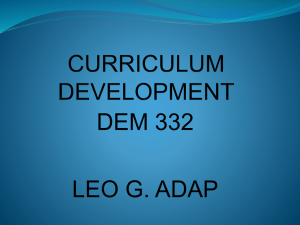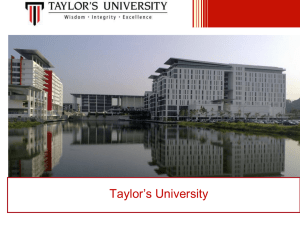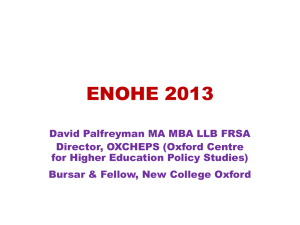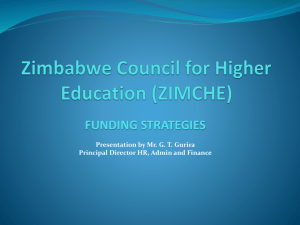Southampton Institute
advertisement
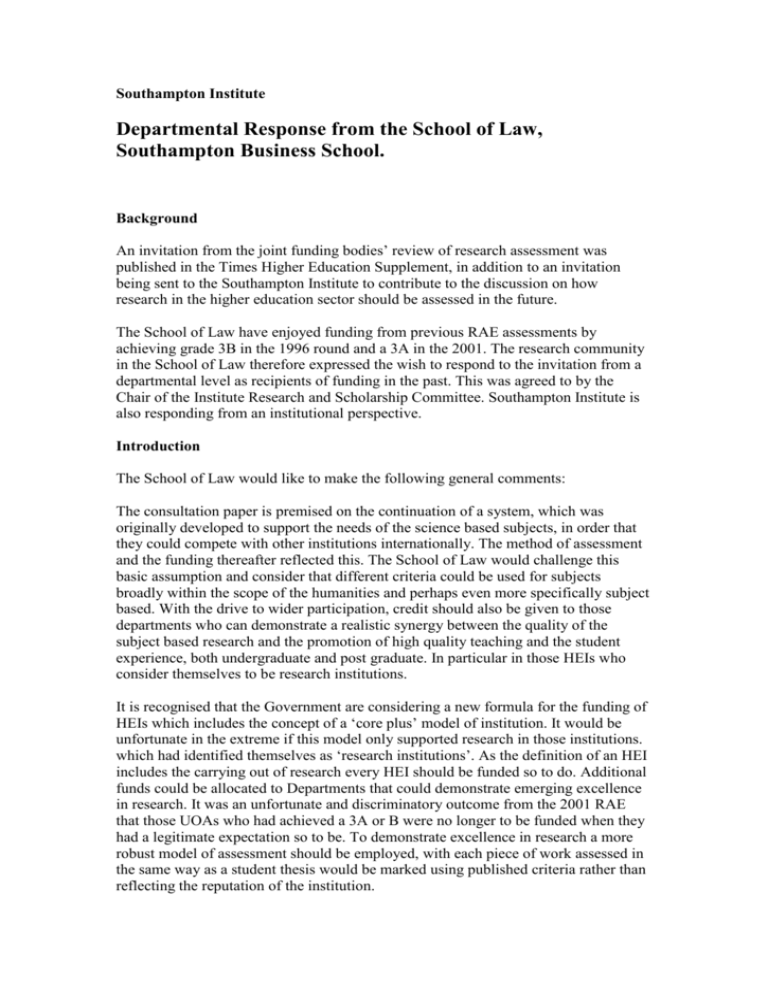
Southampton Institute Departmental Response from the School of Law, Southampton Business School. Background An invitation from the joint funding bodies’ review of research assessment was published in the Times Higher Education Supplement, in addition to an invitation being sent to the Southampton Institute to contribute to the discussion on how research in the higher education sector should be assessed in the future. The School of Law have enjoyed funding from previous RAE assessments by achieving grade 3B in the 1996 round and a 3A in the 2001. The research community in the School of Law therefore expressed the wish to respond to the invitation from a departmental level as recipients of funding in the past. This was agreed to by the Chair of the Institute Research and Scholarship Committee. Southampton Institute is also responding from an institutional perspective. Introduction The School of Law would like to make the following general comments: The consultation paper is premised on the continuation of a system, which was originally developed to support the needs of the science based subjects, in order that they could compete with other institutions internationally. The method of assessment and the funding thereafter reflected this. The School of Law would challenge this basic assumption and consider that different criteria could be used for subjects broadly within the scope of the humanities and perhaps even more specifically subject based. With the drive to wider participation, credit should also be given to those departments who can demonstrate a realistic synergy between the quality of the subject based research and the promotion of high quality teaching and the student experience, both undergraduate and post graduate. In particular in those HEIs who consider themselves to be research institutions. It is recognised that the Government are considering a new formula for the funding of HEIs which includes the concept of a ‘core plus’ model of institution. It would be unfortunate in the extreme if this model only supported research in those institutions. which had identified themselves as ‘research institutions’. As the definition of an HEI includes the carrying out of research every HEI should be funded so to do. Additional funds could be allocated to Departments that could demonstrate emerging excellence in research. It was an unfortunate and discriminatory outcome from the 2001 RAE that those UOAs who had achieved a 3A or B were no longer to be funded when they had a legitimate expectation so to be. To demonstrate excellence in research a more robust model of assessment should be employed, with each piece of work assessed in the same way as a student thesis would be marked using published criteria rather than reflecting the reputation of the institution. Frequency of the reviews should be adjusted to allow for the completion of longer projects and to avoid the ‘bunching’ of submission for publication. Perhaps a number of like HEIs could be assessed in any one year in order that various types of institutions could be assessed against each other. One suggestion is that selfassessment could take place with institutions pairing up to verify each other’s results. The pairs would be changed for each exercise. It was the strong opinion of the School of Law that the number of pieces submitted should be reduced in order that academics could concentrate on quality rather than quantity. The most important features of an assessment process are fairness and transparency. Group 1: Expert review a) b) c) d) e) Prospective assessment should be an element, as this would have the facility to support emerging centres within the new university/college sector. Notwithstanding the government view that there should be a degree of difference among HEIs, to comply with the legal definition of an institution of higher education some research must take place within that institution. The quality of this research should be recognised by the funding bodies; particularly where there are centres of excellence within an institution, which mainly concentrates on teaching and contacts with the community. To establish credibility there must be an element of retrospective assessment. Feedback from the UOA 36 Law in all the previous assessments, the panel has commented that only RAE 2 was considered. However, old universities should not be permitted to trade on their reputation to assert that all future research carried out there will be of high quality. As to type of data to be considered there were two schools of thought. i. That the entire research output should be submitted with one primary piece submitted in full plus a list of additional publications. ii. That only one piece per academic should be submitted. This would mitigate against the rush to publish work, and would emphasise quality rather than quantity. One problem with the 2001 RAE was the perception that there were no experts in certain emerging bodies of law on the panel. The move toward transparency by publishing the work entered by each institution was to be welcomed. However, it was strongly felt that the pieces of work, which were assessed at international level, should be identified, as work submitted by some 5* rated institutions was considered to be of less quality. In addition why is the piece considered to be a primary reference rather than additional. This would also give a benchmark for other aspiring groups. The assessment should be made according to groups, as this is the only way to reward those who had produced the work. The assessment of subjects or themes is unavoidable if true comparability is to take place. It is a major weakness to assess output rather than outcomes. Group 2: Algorithm a) b) c) d) e) No. As indicated in the consultation paper. No Groups could cite each other by arrangement. The problem with this approach is that it assesses research activity rather than quality. A citation is not necessarily a sign of quality. It is too easy for groups of associates to cite each other or themselves. Alternatively a citation could be a criticism. Group 3: Self-assessment a) b) c) d) e) f) See response to Group 1: Expert review. In addition institutions could include aspects of their research which support their particular mission, but all institutions should indicate how their research relates to their teaching. Assessments should be a combination of both retrospective to establish credibility and prospective to allow for emerging departments to demonstrate their potential. Each institution will have a Quality Standards and Assessment department which monitors all work carried out within the institution. Some departments, it is accepted are more robust than others, but generally accepted benchmarks could be issued. Each institutions could then add to these benchmarks to reflect their mission. Institutions could be paired to validate each other’s self-assessment against a published set of criteria. The pairing would reflect the position of the institution within the sector and each pairing would be changed for each assessment exercise. All assessment takes time and effort if done correctly but is necessary for the transparency of allocation of public funds. The institution could demonstrate the correlation of the research with the mission of the institution. Group 4: Historical ratings This would not be an acceptable system, as it would only re-introduce the old binary divide. In addition it would militate against current institutions following the examples of Warwick and, more recently Portsmouth, Universities in becoming respected institutions, which carry out good research, in a relatively short time. Group 5: Crosscutting themes a) An assessment of the research base would validate the quality of academic activity within an HEI. This in turn could be used to support undergraduate teaching; post-graduate teaching and support for research degree candidates. These activities could then be properly funded to include the research activity necessary to support the teaching and research student support. b) c) d) e) f) g) The assessment should take place on a rolling programme in order that there is less competition for publication at any given time. This would allow for a more considered allocation of space by the editors of academic journals in order to include good well researched articles from academics from a more diverse number of institutions. Research should be assessed against a published set of criteria for each subject. The quality of Articles should be assessed against published criteria. It is an accepted fact that not all subjects need the same amount of funding to support good research. For some subjects both time and a good library are the basic essentials, whereas for the science based subjects major funding may be needed to purchase expensive technology. However, it is the allocation of funding between institutions, which creates the greatest inequality. If the quality of research is to be benchmarked against international competition, the criteria for what constitute international should be transparent. In the 2001 RAE some work which was assessed as 5/5* was well below this standard and included chapters in undergraduate textbooks which did not go beyond accepted theories and doctrine. How did these qualify as primary reference point? If numerous departments produce quality research they should be rewarded and the size of the subject pot should reflect this. Given that public money must reflect the public interest in the strategic importance of areas of specific research then this may give rise to additional funds in any ‘subject pot’. This would be difficult to support as it would militate against emerging research interests and ‘blue skies’ research, which may or may not have an economic benefit, which may or may not attract external funding. The needs of research active academics change with time and improved technology. To base the ‘subject pot’ on historic distribution disregards this fact. We support the concept that the system should provide a ladder of improvement so that all researchers and institutions have the opportunity to demonstrate potential. This would necessitate the retention of core funding for research in all HEIs with the re-introduction of the CollR grants in order that each institution may use those grants selectively to achieve higher quality ratings in future research assessment exercises. This also encourages collaboration and the sharing of good practice. Each RAE panel published it’s own assessment criteria for the 2001 RAE. These differed substantially in a number of different ways. In addition, in the informal feedback from the Law panel it was expressed that only RA2 was assessed and the research culture and support was not included. This militates against emerging departments who must set up the facilities and procedures to encourage a research culture and output. But these efforts were not recognised in the assessment. Each subject, therefore already use different assessment criteria. If this is so then the criterion should be open and published in order to create a proper benchmark against which departments can assess the quality of the research articles they submit for assessment. If self-assessment is adopted then each institution can publish its own criteria. It should be the department or research group who determine the submission of their research. This would reflect the knowledge and experience of those h) i) academics within the department to put together a submission which best reflected the research carried out therein. This would not be unfair to the institution, as the departmental submission would in turn reflect the strategic mission of the institution in the research carried out. These issues should be addressed by the institutions under their Human Resource policy. If the assessment were both fair and transparent, then the remainder of the points would naturally be included. Professor Patricia Park Head of Law Research Centre Tel: 023 8031 9850 e-mail: patricia.park@solent.ac.uk
